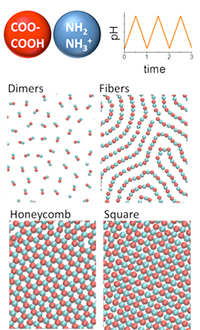Dissipative Self-Assembly of Particles Interacting through Time-Oscillatory Potentials
June 23, 2014
Scientific Achievement
Dissipative self-assembly, the emergence of ordered structures due to continuous input of energy, is proposed via the oscillations of interparticle potentials.

We studied dissipative self-assembly in a mixture of particles coated by weak acids (red particles) and weak bases (blue particles) in the presence of continuous oscillations of pH. Different structures form (bottom panels) depending on the density of the particles, the strength of electrostatic interactions and the shape of the pH oscillations.
Significance and Impact
Provides a new strategy to achieve and study dissipative self-assembly which is still a poorly understood phenomenon.
Research Details
- Non-trivial dissipative structures can form as a result of oscillation of interparticle potentials.
- We considered, as a case study, a binary mixture of particles coated by weak acids and weak bases under externally controlled oscillations of pH.
- The particles in this system self-assemble in different structures (dimers, fibers, honeycombs, and square lattices).
- Dissipative structures only form when the pH oscillations are faster than the diffusional timescale of the particles and the order of the structures decays when the oscillations stop.
Dissipative Self-Assembly of Particles Interacting through Time-Oscillatory Potentials
Tagliazucchi, M., Weiss, E. A., Szleifer, I.
Proc. Natl. Acad. Sci. U.S.A. 111, 2014, 2162-2167.
Work performed at Northwestern University
